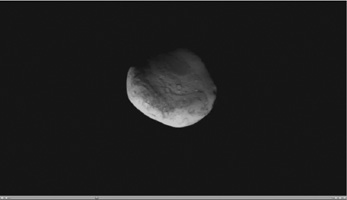
Click on the image for the movieThis movie shows what it was like for NASA's Stardust spacecraft to fly by comet Tempel 1. It covers the period between 8:35:26 p.m. to 8:43:08 p.m. PST on Feb. 14, 2011 (4:35:26 a.m. to 4:43:08 a.m. UTC, Feb. 15, 2011, according to the clock kept aboard the spacecraft). The spacecraft images were taken at a distance of 2,462 kilometers (1,530 miles) away from the center of the comet and get to within 185 kilometers (115 miles). By the end of the movie, the spacecraft is 2,594 kilometers (1,611 miles) away from the center of the comet.
At the time of the encounter, comet Tempel 1 was approximately 335 million kilometers (208 million miles) away from Earth. Tempel 1 is oblong in shape and has an average diameter of about 6 kilometers (4 miles).
Stardust-NExT is an extended mission for the comet chaser, which previously flew past comet Wild 2 and returned samples from its coma to Earth. During this latest encounter, the spacecraft took images of the comet's surface and observed changes that occurred since a NASA spacecraft last visited. (NASA's Deep Impact spacecraft executed an encounter with Tempel 1 in July 2005).
Stardust-NExT is a low-cost mission that is expanding the investigation of comet Tempel 1 initiated by the Deep Impact spacecraft. The mission is managed by the Jet Propulsion Laboratory, a division of the California Institute of Technology, Pasadena, Calif., for NASA's Science Mission Directorate in Washington. Lockheed Martin Space Systems in Denver built the spacecraft and manages day-to-day mission operations.
More information about Stardust-NExT is at http://stardustnext.jpl.nasa.gov.

